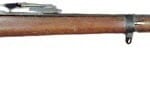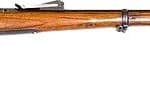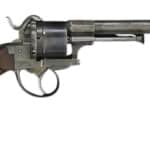
Introduction to the Lebel Model 1886
The history of military firearms is marked by key innovations that redefine the battlefield, and the Lebel Model 1886 stands among the most transformative. Known officially as the Fusil Modèle 1886 M93, this French bolt-action infantry rifle was the first military rifle designed for smokeless powder, heralding a new era of warfare. Its introduction signified a quantum leap in firearm technology, setting the stage for rapid advancements in ballistic performance, weapon durability, and battlefield tactics.
The Birth of a Revolution: Development and Design
The origins of the Lebel Model 1886 rifle lie in the aftermath of the Franco-Prussian War (1870-1871), a conflict that left France humiliated and eager to modernize its military. By the early 1880s, the German Empire had begun adopting new small-bore rifles, such as the Gewehr 71/84, and was actively working on higher-velocity ammunition. France needed to leap ahead technologically to regain its military standing.
Smokeless Powder and the Creation of the 8mm Lebel Cartridge
The turning point came in 1884, when French chemist Paul Vieille invented Poudre B, the first practical smokeless powder. Unlike traditional black powder, Poudre B burned cleanly, produced far less residue, and dramatically increased bullet velocity. This breakthrough allowed for the development of smaller-caliber, high-velocity cartridges, improving both range and accuracy.
Recognizing the significance of smokeless powder, the French military tasked the design teams at the Atelier de Puteaux (APX) to create a rifle capable of utilizing this new propellant. The result was the 8×50mmR Lebel cartridge, the world’s first bottlenecked, rimmed cartridge designed for smokeless powder. This ammunition initially featured the Balle M, a full-metal-jacket, round-nose bullet with a velocity of 2,083 feet per second (635 m/s).
A significant improvement came in 1898 with the Balle D, a solid brass, boat-tailed bullet that increased velocity to 2,378 feet per second (725 m/s). The Balle D was the first mass-adopted spitzer (pointed) bullet, vastly improving long-range ballistics and influencing later designs worldwide.
The Lebel Rifle: Design and Features
The Lebel Model 1886 rifle incorporated several cutting-edge and traditional elements:
- Action: The bolt-action mechanism was based on the Mle 1874 Gras rifle, featuring a rear-locking, rotating bolt. While robust and reliable, it lacked the forward-locking lugs found in later Mauser rifles.
- Magazine: Unlike the clip-fed systems that later became standard, the Lebel used an under-barrel tubular magazine (similar to Winchester lever-action rifles). It held eight rounds in the tube, plus one in the chamber, for a total capacity of nine rounds.
- Sights: The Lebel featured graduated rear sights up to 2,000 meters, but practical accuracy was limited to about 400-500 meters.
- Length and Weight: At 51.2 inches (1,300 mm) and 9.2 lbs (4.2 kg) unloaded, the Lebel was long and cumbersome, especially in the trenches of World War I.
- Bayonet: The rifle was issued with a cruciform spike bayonet (Model 1886 "Rosalie"), which was effective but considered heavy and impractical by soldiers.
Advantages and Drawbacks
The Lebel Model 1886 was revolutionary for its smokeless powder ammunition, but its design had several drawbacks:
✅ First rifle to use smokeless powder, giving France an early technological edge. ✅ Highly durable and reliable in extreme conditions. ✅ Exceptional ballistic performance with the introduction of the Balle D bullet in 1898.
However:
❌ Tubular magazine was outdated and slow to reload compared to emerging clip-fed designs. ❌ Weight and length made handling cumbersome, especially in trench warfare. ❌ Rear-locking bolt design was weaker than Mauser-style forward-locking systems.
Operational History: From Colonial Wars to World War II
World War I Service and the Rise of the Berthier Rifle
When World War I erupted in 1914, the Lebel Model 1886 was still the primary service rifle of the French Army. It proved rugged and accurate, but its long length, slow reloading, and awkward handling in trench warfare led to increasing dissatisfaction among troops.
The French Army responded by adopting the Berthier Model 1907/15 and M16 rifles, which featured three-round (later five-round) Mannlicher-style clip-fed magazines. By 1916, these were supplementing the Lebel in front-line units. However, the Lebel remained in widespread service until the war’s end.
Interwar Period and World War II
By the late 1930s, the Lebel was officially obsolete, replaced by the MAS-36 bolt-action rifle, but it remained in service with French reserves and colonial troops. During World War II, large numbers were captured by German forces, who reissued them under the designation Gewehr 1886/93(f).
Even after WWII, the Lebel saw limited use in the First Indochina War and the Algerian War, primarily in second-line roles.
Legacy and Influence on Future Firearms
The Lebel Model 1886 left a lasting imprint on firearms development:
- Balle D bullet (1898) pioneered spitzer projectiles, influencing modern ammunition design.
- First smokeless powder military rifle, setting a standard for global military adoption.
- Berthier and MAS-36 rifles were direct successors, incorporating lessons learned from the Lebel's shortcomings.
Although long obsolete, surviving Lebel rifles remain prized collectibles among military historians and firearm enthusiasts. Many are preserved in museums and private collections, serving as a tangible reminder of the rapid advancements that defined late 19th and early 20th-century military technology.
Conclusion: The Lebel Model 1886 in Historical Context
The Lebel Model 1886 was not just a rifle; it was a revolution. As the first smokeless powder firearm, it transformed military strategy, forcing nations to rethink their small arms technology almost overnight. Though its tube magazine and outdated bolt system were quickly eclipsed by more advanced designs, its impact on ballistics and ammunition technology was profound.
While today it is largely a relic, the Lebel’s legacy endures in every modern rifle cartridge and every battlefield innovation that followed its introduction. It stands as a testament to France’s ingenuity at a critical moment in military history, securing its place as one of the most influential firearms ever produced.
FAQs About the Lebel Model 1886
Q: Why was the Lebel Model 1886 significant?
A: It was the first military rifle designed for smokeless powder, dramatically increasing range and accuracy.
Q: What were the main weaknesses of the Lebel?
A: The tube magazine made reloading slow, and its long length and weight made it cumbersome.
Q: Did the Lebel influence later firearms?
A: Yes, it led to the development of the spitzer bullet and influenced the Berthier and MAS-36 rifles.
Read more about this and other French military rifles here:

If you know of any forums or sites that should be referenced on this listing, please let us know here.




